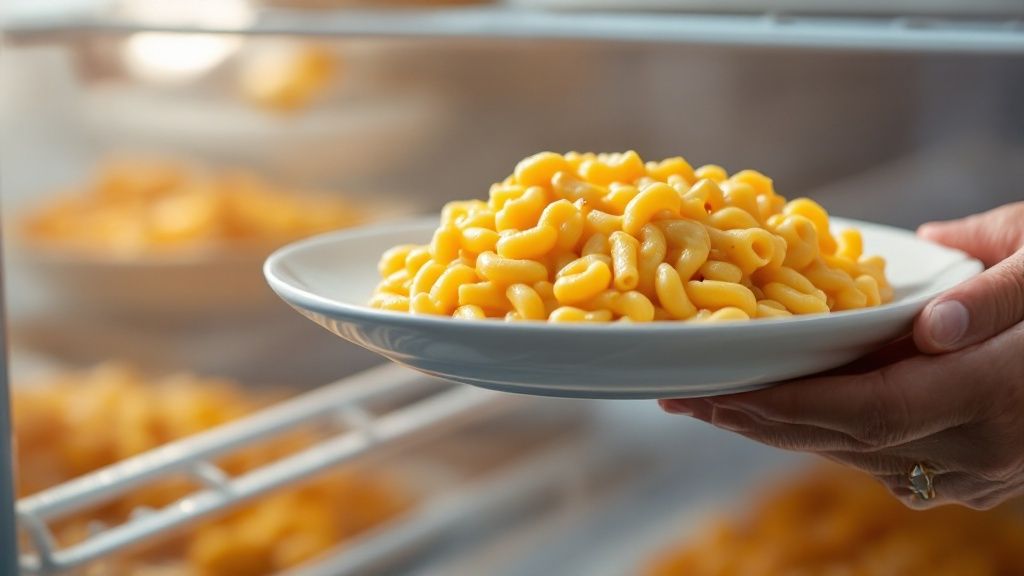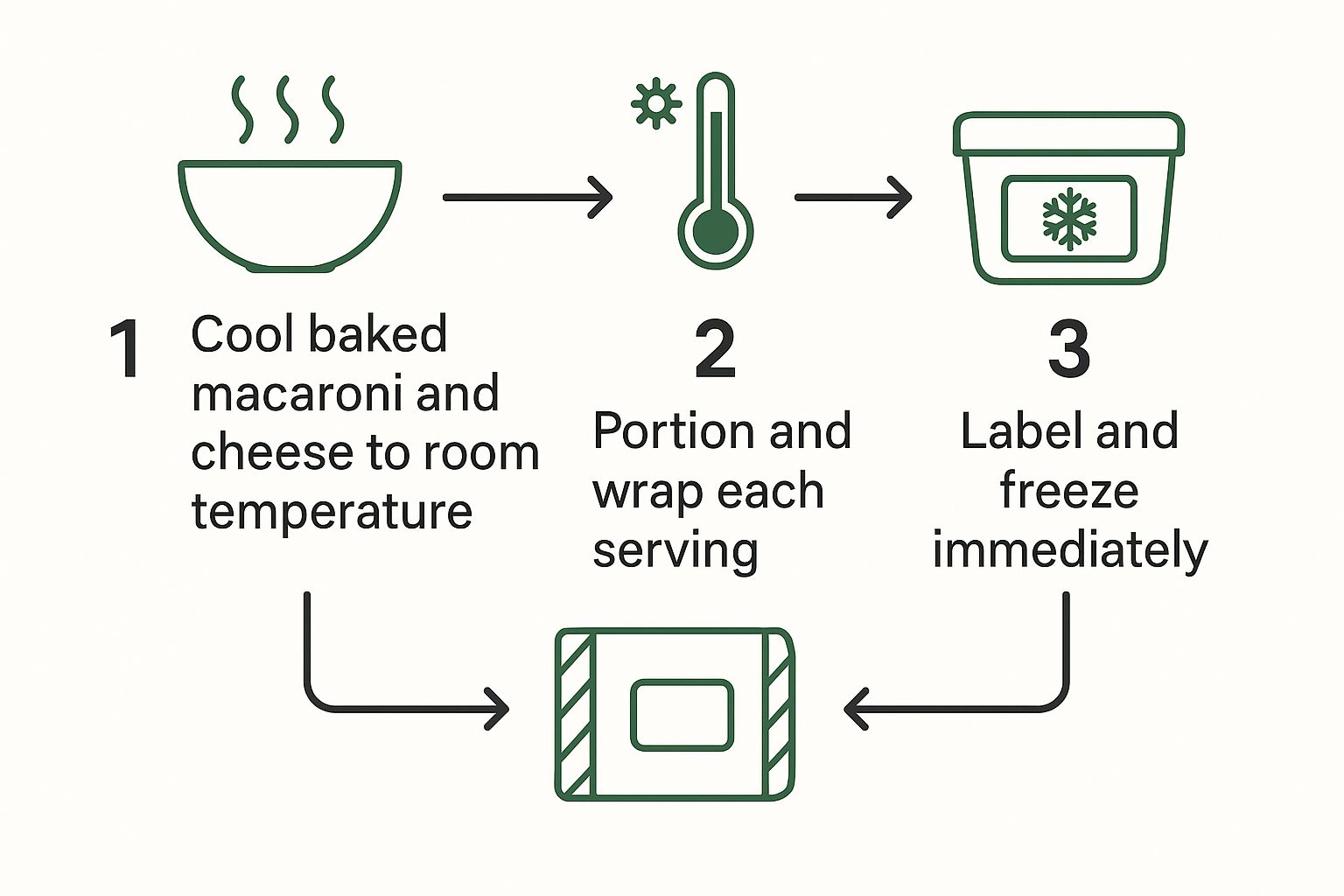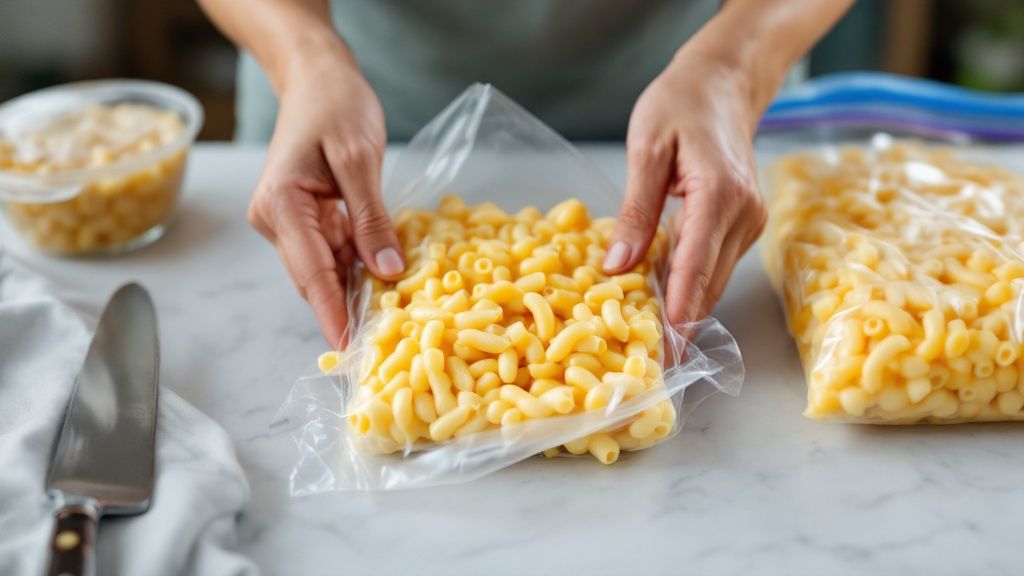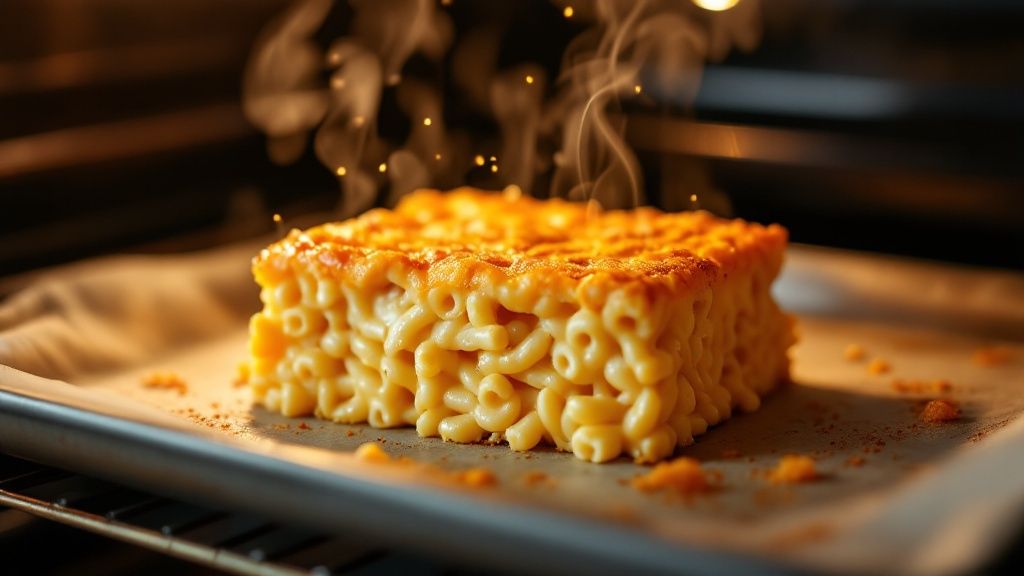Can You Freeze Baked Macaroni and Cheese? A Guide
Of course you can freeze baked macaroni and cheese! In fact, it’s one of my go-to strategies for saving leftovers or getting a head start on a future comfort food craving. With the right approach, you can lock in that creamy texture and rich flavor for months.
Why Freezing Mac and Cheese Is a Game Changer

I know what you’re thinking—freezing a dairy-heavy pasta dish sounds like a recipe for disaster. But trust me, it works beautifully once you know a few simple tricks. Success really comes down to just two things: the stability of your cheese sauce and the structure of your pasta.
A rich, full-fat cheese sauce is non-negotiable here. Why? The higher fat content from ingredients like whole milk, real butter, and robust cheeses like sharp cheddar or Gruyère is what prevents the sauce from breaking or turning grainy when it thaws. Low-fat dairy has a higher water content, which forms pesky ice crystals that destroy the sauce’s emulsion and ruin the texture.
Proper prep is key to making sure your mac and cheese reheats like a dream. In this guide, I’ll walk you through everything I’ve learned, from picking the best ingredients to my favorite reheating methods.
By mastering a few simple techniques, you can confidently stock your freezer with perfectly portioned mac and cheese, ready for a quick and satisfying meal anytime. Say goodbye to food waste and hello to effortless dinners.
Preparing Your Mac and Cheese for Freezing
The secret to a fantastic frozen mac and cheese starts way before it hits the freezer. Honestly, how you prep it is the single most important factor. It’s what makes the difference between a creamy, dreamy meal and a separated, mushy mess down the road.
Let’s start with the pasta. The biggest rookie mistake is cooking it all the way through. You absolutely have to undercook your pasta just a bit. If the box says to boil for eight minutes, I always pull it out around the six-minute mark. It’s going to soften more during the freezing and reheating stages, and this little trick is your best defense against it turning into a sad, mushy blob later.
The Importance of a Rich Cheese Sauce
When it comes to the sauce, its stability is everything. Low-fat dairy products are the enemy here because they have more water. That water forms ice crystals that will break your sauce’s emulsion, leaving you with a gritty, grainy texture when you thaw it out. Nobody wants that.
To sidestep this disaster, you need to go all-in with full-fat ingredients. I’m talking:
- Whole Milk: This gives you the creaminess and fat content needed for a stable sauce.
- Real Butter: It’s the foundation of a good roux and keeps everything smooth.
- High-Fat Cheeses: Think sharp cheddar, Gruyère, or Colby. These guys melt beautifully and are less likely to separate.
I also have a personal rule: always make a little extra sauce. A slightly “wetter” mac and cheese going into the freezer means it will still be perfectly moist and luscious after reheating, since the pasta will inevitably soak up some of that liquid. If you’re looking for more tips on prepping meals ahead of time, some of the newer AI meal planning resources offer some great structured guidance.
Pro Tip: Your cheese sauce is your best insurance against a dry, disappointing result. Don’t be shy with it—a generous, rich sauce is the key to freezer success. This principle of locking in moisture is similar to techniques used when learning https://theculinarycollectiveatl.com/how-to-freeze-fresh-zucchini/ to preserve its texture.

From cooling it down properly to wrapping it tight, following this workflow is how you protect your dish from freezer burn and set it up for a perfect comeback. And it makes sense—people want great food that fits their busy lives. The global frozen cheese market is even projected to hit USD 11.6 billion in 2025, which just goes to show how much we all love having delicious meals ready to go.
How to Package and Store for Maximum Freshness

Proper packaging is your best defense against freezer burn. It’s what stands between you and a future meal that tastes just as good as the day it was made.
But before you even think about wrapping, your mac and cheese needs to be completely cool. Trapping steam is the enemy here—it creates ice crystals that will turn your creamy masterpiece into a watery, separated mess when you thaw it.
Once it’s at room temperature, you have to decide on the right container. This really comes down to how you plan on eating it later.
- For Individual Servings: I love using smaller airtight containers or even those handy Souper Cubes for single portions. They’re perfect for grabbing a quick lunch.
- For Family-Sized Meals: A freezer-safe glass baking dish works great, as does a disposable aluminum foil pan if you want easy cleanup.
No matter what you use, the wrapping technique is what truly locks in the freshness and keeps that dreaded freezer burn away.
Wrapping for Ultimate Protection
I swear by a double-wrap system to create a perfect airtight seal. It’s a simple two-step process that makes all the difference.
First, take a sheet of plastic wrap and press it directly onto the surface of the mac and cheese. This is the most important part—it gets rid of any air pockets touching the food itself, which is where freezer burn starts.
Next, wrap the entire container tightly with a layer of heavy-duty aluminum foil. This second layer acts as a barrier, protecting your dish from freezer odors and moisture loss. And please, do yourself a favor and label it with the date! Stored this way, it will taste its best for up to three months.
You’re not alone in wanting high-quality freezer meals. The global frozen cheese market was valued at USD 3.09 billion in 2021 and continues to grow. This trend shows a huge consumer demand for meals that offer both convenience and quality, and it’s fascinating to discover more insights about the frozen food market growth to see how freezing homemade mac and cheese fits right in.
Taking those few extra minutes to package your dish correctly is the key. It’s your guarantee that a delicious, creamy meal is always ready when you are.
Thawing and Reheating for Perfect Creaminess

This is where all your careful prep pays off. Getting the reheating process right is the final, crucial step to making sure your mac and cheese tastes just as creamy as the day you made it. If you rush this part, you can easily undo all that hard work, and nobody wants a separated sauce or cold spots.
The absolute best way to do this is to thaw it overnight in the refrigerator. I know, it takes patience, but this slow, gentle approach is the gold standard for a reason. It gives the fats and dairy in your cheese sauce a chance to come back together gradually. Drastic temperature changes are what cause a creamy sauce to break, so giving it 8-12 hours in the fridge is your best insurance policy against a grainy mess.
Bringing Back the Creamy Goodness
Once your mac and cheese is fully thawed, it’s time to bring it back to life. For me, the oven is the only way to go. It provides the gentle, even heat needed to warm everything through without scorching the bottom or drying out the top.
Here’s my foolproof method:
- First, get your oven preheating to 375°F (190°C).
- Next, cover the dish tightly with aluminum foil. This is key—it traps steam, which helps reheat the pasta and sauce evenly while preventing the top from burning to a crisp.
- For a standard 9×13 inch dish, you’ll want to bake it for about 20-30 minutes. If you’re just reheating a smaller portion, start checking on it around the 15-minute mark. You’ll know it’s ready when it’s hot and bubbly around the edges.
Want that crispy top back? Just pull the foil off for the last five minutes of baking or give it a quick blast under the broiler. Just be sure to watch it like a hawk so it doesn’t go from golden to burnt!
My Favorite Revival Trick: Sometimes, even with perfect prep, the pasta soaks up a bit more moisture than you’d like. If your mac and cheese looks a little dry after reheating, don’t panic. Just stir in a splash of warm milk. It works like magic to bring back that perfectly creamy, luscious consistency.
Properly reheating your freezer meals makes all the effort worth it. This technique isn’t just for pasta, either. Learning the best way to reheat any freezer meal is a great kitchen skill, just like knowing https://theculinarycollectiveatl.com/does-chili-freeze-well/ to preserve its texture for later. Follow these simple steps, and your frozen baked macaroni and cheese will be a triumph every time.
Common Mistakes to Avoid When Freezing Mac and Cheese
Knowing you can freeze baked mac and cheese is the easy part. Actually pulling it off without ending up with a sad, grainy mess is where the real skill comes in. I’ve seen plenty of well-intentioned efforts go wrong, but the good news is that the most common pitfalls are surprisingly easy to sidestep.
One of the biggest culprits of a freezer-fail is a grainy or broken cheese sauce. Nine times out of ten, this comes down to using low-fat dairy. Skim milk and low-fat cheeses just have too much water, which forms ice crystals that completely wreck the sauce’s creamy emulsion. Do yourself a favor and stick with full-fat milk and cheese. Your future self will thank you.
Pasta and Packaging Problems
Another classic mistake is rushing the cooling process. If you wrap up your mac and cheese while it’s still warm, you’re just trapping steam. That steam turns into condensation, then ice crystals, which ultimately leads to a watery, disappointing dish when you reheat it. Patience is key here—let it cool completely to room temperature first.
This brings me to packaging. Don’t skimp on it! A single, sad layer of foil is a direct invitation for freezer burn, which sucks the life out of your food and leaves behind a funky taste. You need to create an airtight seal to protect your masterpiece.
The most common freezer mistakes often lead to disappointing meals and unnecessary food waste. A simple, mindful approach to preparation and storage can make all the difference, aligning with effective food waste reduction strategies that save both your dinner and your budget.
Finally, let’s talk pasta. Overcooking it at the start is a fatal flaw. Remember, those noodles are going to cook a second time when you reheat the dish. To avoid a mushy, lifeless texture, you absolutely have to undercook the pasta. Boil it for 1-2 minutes less than the package instructions say. This little step is non-negotiable if you want that perfect al dente bite later.
Got Questions? We’ve Got Answers
Even after walking through the steps, a few questions always pop up. It’s totally normal. Let’s tackle some of the most common things people ask when freezing mac and cheese.
How Long Does Frozen Mac and Cheese Last?
For the absolute best flavor and texture, you’ll want to enjoy your frozen mac and cheese within two to three months.
Technically, it will stay safe to eat much longer than that as long as your freezer holds a steady 0°F (-18°C). But after that three-month mark, you’ll start to notice a real decline in quality. Do yourself a favor and slap a label on that container with the date—your future self will thank you for taking the guesswork out of it.
What About Freezing It With a Breadcrumb Topping?
You can, but I honestly don’t recommend it. That signature crunch from the breadcrumbs is the first thing to go. Once they freeze and thaw, they just get… sad and soggy. It’s not the vibe we’re going for.
My pro-tip is to freeze the mac and cheese without the topping. When you’re ready to bake it, just whip up a fresh batch of buttered breadcrumbs and sprinkle them on top before it goes into the oven. It’s a tiny bit of extra effort that pays off big time with that perfect, golden-brown crunch.
Is It Better to Freeze Mac and Cheese Baked or Unbaked?
Both ways totally work, but freezing it unbaked has a slight edge in my book.
When you assemble the whole casserole but stop right before baking, you get to cook it completely fresh later on. I personally prefer this method because it nearly eliminates the risk of overcooked, mushy pasta during the reheat. But hey, freezing a fully baked dish is an amazing way to save leftovers and is still a fantastic, convenient option.
The real secret to great freezer meals often comes down to texture. Freezing mac and cheese unbaked is the best way to preserve that perfect pasta bite, since you’re cooking it fresh instead of just reheating it.
At Culinary Collective Atl, we believe that delicious, high-quality meals should fit into your life, not the other way around. Let our expert private chefs craft personalized dining experiences for you.





